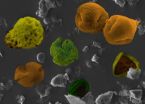(Press-News.org) San Diego, CA, November 10, 2010 – Heavy drinking among college students results in over 1800 deaths each year, as well as 590,000 unintentional injuries, almost 700,000 assaults and more than 97,000 victims of sexual assaults. In a new study published in the December issue of the American Journal of Preventive Medicine, researchers report on the results of the Safer California Universities study, a successful community-wide prevention strategy targeted at off-campus settings. This is one of the first studies to focus on the total environment rather than on prevention aimed at individuals.
The authors found significant reductions in the incidence and likelihood of intoxication at off-campus parties and bars/restaurants for Safer intervention universities. Students from Safer universities were 6% less likely to drink to intoxication during the last time they were at any of the targeted settings, 9% for off-campus parties, and 15% for bars/restaurants. There was also evidence that drinking was reduced at fraternities and sororities. These declines were equivalent to 6,000 fewer incidents of intoxication at off-campus parties and 4,000 fewer incidents at bars & restaurants during the fall semester at each intervention schools relative to controls. Furthermore, stronger intervention effects were achieved at Safer universities with the highest level of implementation.
"These findings should give college administrators some degree of optimism that student drinking is amenable to a combination of well-chosen, evidence-based universal prevention strategies," commented lead investigator Robert F. Saltz, PhD, Pacific Institute for Research and Evaluation (PIRE), Berkeley, CA. "Here, one set of alcohol control strategies was found to be efficacious, but other combinations may work as well, or even better. With a growing body of such evidence, and combined with strategies already shown to be effective, it will be possible to craft a comprehensive prevention program that ratchets down the harm currently produced by alcohol use on and near college campuses."
The Safer California Universities study involved 8 campuses of the University of California and 6 campuses in the California State University system. Half of these schools were randomly assigned to the Safer intervention, which took place in the fall semesters of 2005 and 2006. Student surveys were completed by undergraduates in four fall semesters (2003 through 2006) and random samples of 1,000 to 2,000 students per campus per year were analyzed. Students were asked about where they drank, whether they had gotten drunk, and whether they had engaged in so-called "binge drinking." They were also questioned about their grade point averages and their general health, as well as other sociodemographic characteristics.
Safer environmental interventions included nuisance party enforcement operations, minor decoy operations, DUI checkpoints, social host ordinances, and use of campus and local media to increase the visibility of environmental strategies. Intervention campuses differed in their level of implementation, but all concentrated on off-campus activities for drinking.
INFORMATION:
Kenny Goldberg, Health Reporter for KPBS Radio, 89.5 FM in San Diego, interviewed lead investigator Robert J. Saltz. Go to http://www.ajpm-online.net/content/podcast_collection to listen to this podcast.
The article is "Alcohol Risk Management in College Settings: The Safer California Universities Randomized Trial" by Robert F. Saltz, PhD; Mallie J. Paschall, PhD; Richard P. McGaffigan, MSW; and Peter M. Nygaard, PhD. It appears in the American Journal of Preventive Medicine, Volume 39, Issue 6 (December 2010) published by Elsevier. doi: 10.1016/j.amepre.2010.08.020
This research was made possible by a grant from the National Institute on Alcohol Abuse and Alcoholism (NIAAA) with supplemental funding from the Substance Abuse and Mental Health Services Administration (SAMHSA).
END
The laboratory of Huda Zoghbi, where the discovery that mutations in the gene MECP2 cause the severe childhood neurological disorder Rett Syndrome was made, has taken yet another step toward unraveling the complex epigenetic functions of this gene, implicated also in cases of autism, bipolar disease and childhood onset schizophrenia. The November 11 issue of Nature reports that removing MECP2 from a small group of neurons that typically make the inhibitory neurotransmitter, GABA, recapitulates many symptoms of Rett as well as numerous neuropsychiatric disorders.
The ...
Millions will escape hunger and poverty in a widening campaign to achieve global food security and deliver major environmental gains within 25 years
Hanoi, Vietnam – One of the world's largest global scientific partnerships for sustainable agricultural development has launched a bold new research initiative that aims to dramatically improve the ability of rice farmers to feed growing populations in some of the world's poorest nations. The efforts of the Global Rice Science Partnership, or GRiSP, are expected to lift 150 million people out of poverty by 2035 and prevent ...
LA JOLLA, CA—A collaborative effort between researchers at the Salk Institute for Biological Studies and the University of California, San Diego, successfully used human induced pluripotent stem (iPS) cells derived from patients with Rett syndrome to replicate autism in the lab and study the molecular pathogenesis of the disease.
Their findings, published in the Nov. 12, 2010, issue of Cell, revealed disease-specific cellular defects, such as fewer functional connections between Rett neurons, and demonstrated that these symptoms are reversible, raising the hope that, ...
WHAT:
The 2010 Annual Meeting of the American College of Allergy, Asthma & Immunology (ACAAI) brings together leading allergists and immunologists from around the world.
WHO:
Scientists supported by the National Institute of Allergy and Infectious Diseases (NIAID), part of the National Institutes of Health, will present their latest research findings at the ACAAI Annual Meeting. For more than 60 years, NIAID has supported allergy and immunology research at U.S. and international institutions and conducted studies within its own laboratories to improve the health ...
Using induced pluripotent stem cells from patients with Rett syndrome, scientists at the University of California, San Diego School of Medicine have created functional neurons that provide the first human cellular model for studying the development of autism spectrum disorder (ASD) and could be used as a tool for drug screening, diagnosis and personalized treatment.
The research, led by Alysson R. Muotri, PhD, assistant professor of pediatrics, will be published in the November 12 issue of the journal Cell.
"This work is important because it puts us in a translational ...
The presence of certain markers in the urine might be a red flag for acute kidney injury (AKI), according to a study appearing in an upcoming issue of the Journal of the American Society Nephrology (JASN). The results suggest that a simple urine test could help prevent cases of kidney failure.
Unlike heart or brain injuries, which show obvious outward signs, physical symptoms are not typically present with AKI. Researchers have been looking for markers of AKI, with the hope that early detection will lead to early therapy to prevent kidney failure. Richard Zager, MD (Clinical ...
Researchers in France have uncovered a mechanism which explains how biological clocks accurately synchronize to the day/night cycle despite large fluctuations in light intensity during the day and from day to day. Following the identification of two central "clock genes" of a green alga, Ostreococcus tauri, a mathematical model reproducing their daily activity profiles has revealed that their internal clock is influenced by the naturally varying light levels throughout the day only at periods when it needs resetting. The results found by the biologists at Oceanologic Observatory ...
CAMBRIDGE, Mass. — Cat fanciers everywhere appreciate the gravity-defying grace and exquisite balance of their feline friends. But do they know those traits extend even to the way cats lap milk?
Researchers at MIT, Virginia Tech and Princeton University analyzed the way domestic and big cats lap and found that felines of all sizes take advantage of a perfect balance between two physical forces. The results will be published in the November 11 online issue of the journal Science.
It was known that when they lap, cats extend their tongues straight down toward the bowl ...
PHILADELPHIA—An international team of scientists, including a leading evolutionary biologist from the Academy of Natural Sciences, have reset the agenda for future research in the highly diverse Amazon region by showing that the extraordinary diversity found there is much older than generally thought.
The findings from this study, which draws on research by the Academy's Dr. John Lundberg and other scientists, were published as a review article in this week's edition of Science. The study shows that Amazonian diversity has evolved as by-product of the Andean mountain ...
The steamiest places on the planet are getting warmer. Conservative estimates suggest that tropical areas can expect temperature increases of 3 degrees Celsius by the end of this century. Does global warming spell doom for rainforests? Maybe not. Carlos Jaramillo, staff scientist at the Smithsonian Tropical Research Institute, and colleagues report in the journal Science that nearly 60 million years ago rainforests prospered at temperatures that were 3-5 degrees higher and at atmospheric carbon dioxide levels 2.5 times today's levels.
"We're going to have a novel climate ...


